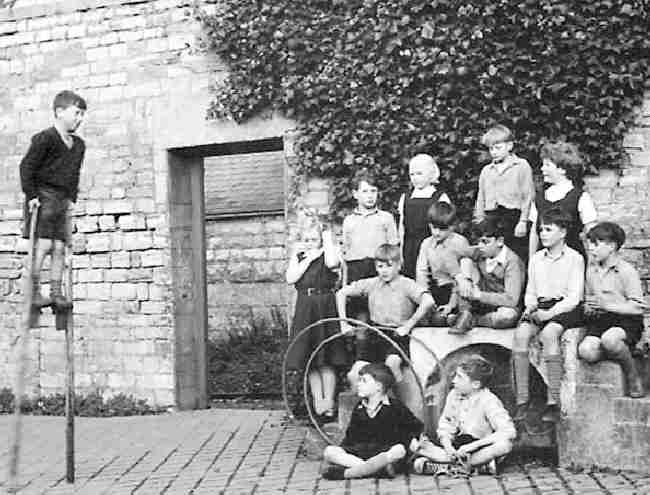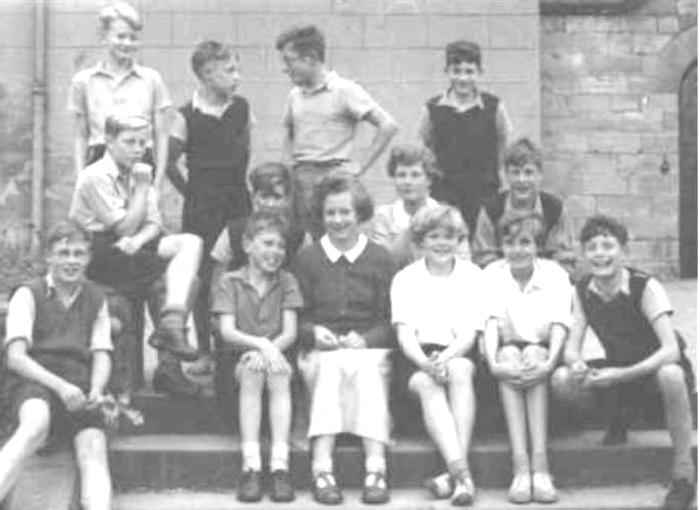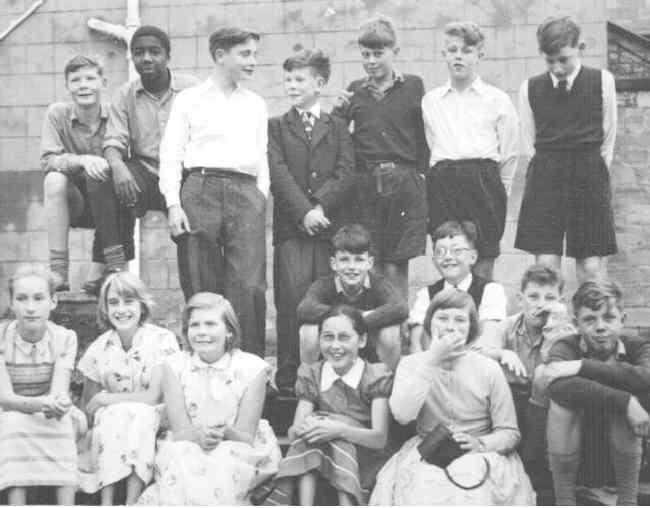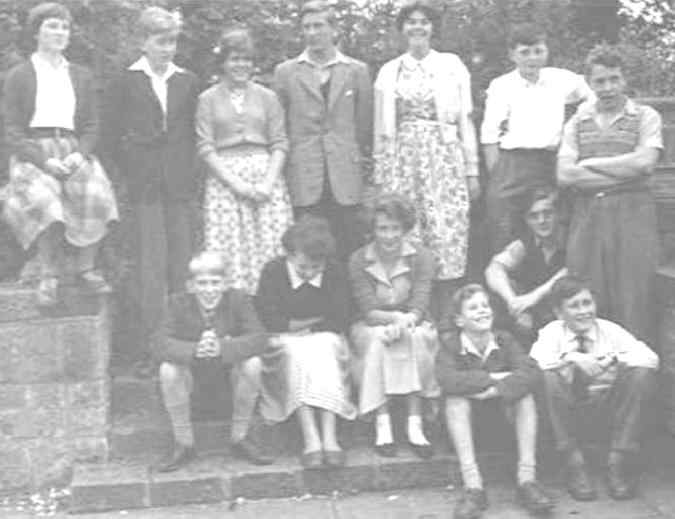
English School Uniform: Individual School -- Wennington School

Figure 1.--This photograph of a junior form was taken about 1951-52. All of the children are wearing the uniform. It looks little different than a comparable prep school at the time. The school here looks to be insisting that the children wear the uniform.
|
|
Wennington School was a private boarding school founded in 1940 during World War II. It was a private, progressive, co-educational boarding school somewhat unusual at the time. The school was founded by Kenneth and Frances Barnes. The school operated until 1975. It had an unusual uniform of bugenday blazers and green corduroy short trousers. I have not noted another school with a uniform quite like this.
Background
Wennington School was a private boarding school. It was a private, progressive, co-educational boarding school somewhat unusual at the time. The school was founded by Kenneth and Frances Barnes. The school was founded founded in 1940 during the darkest days of World War II in Britain.
World War II
As a result of the NAZI Blitz, about 3 million Britons, mostly children, had been evacuated to rural areas and small towns. Most were taken in by private families, but others were taken in by schools and other institutions. The Barnes were offered alease of Wennington Hall, Lunesdale, for a small fee during the War if they would set up a school for the evacuees or those whose homes were destroyed in the bombing.
Foundation
The Barnes were educators who had dreamed for years of opening a progressive school. Kenneth Barnes had had for 10 years been a senior science master at Bedales, Hampshire. This was a well-known private (fee paying) progressive school. He was also knowledgeable about the arts. His brother Frances was also a teacher and a bit of a poet. Both were happy a , while Frances was both teacher and poet. They both loved the atmoshere at Bedales but wanted their own school where they could offer a progressive education to children of modest means and not just children from affluent families. When set up in 1940, Wennington was one of the first co-educational boarding in England. There wasn't much money. The staff wasn't even paid at first. The children were even used in building facilities. This was due to the lack of money and in keeping with the ethos of the school. The school adopted the same basic approach as Bedales. The major difference was tha Bedales students were from affluent families that could expensive school fees. The Barnes set out to create a school that accepted children from a wide range of families, including low income families that could not affoird expensive school fees. The Barnes also sought to create an educational environment tailored for the super-sensitive child who may have lost his sense of balance because of an insecure background.
New Grounds
After the war the school had to relocate. Their was a major problem for a school with few resources. Kenneth Barnes managed to buy a large estate between Wetherby and York, Ingmanthorpe Hall. It had once been which had once been the home of the Montague family and at the time was owned by a Leeds brewer. The school kept vits name and moved to the new site. The stone house dated to 1833, but it proved to be a wonderful location for a school. It radiated security with a home-like atmosphere. There were large and lofty rooms, woderfully panelled walls, and masterfully carved and ceilings and fireplaces. The grounds had wood in which the children loved to play. The school steadily built a reputation for its success in caring for sensitive children.

Figure 2.--All the children in this form 2 class are wearing uniforms. The boys wear sleeveless sweaters. The girls all wear uniforms. The photograph was taken in 1954.
|
|
School focus
The focus of a progressive school was on developing character and personality more than academic skills. This was true at Wennington as well. Gradually the schools began to place a greater emphasis on academics and training boys and girls for careers. At Wennington and other progressive scgools, however, the primary focus was on developing personality.
Gradually importantfacillities like a cince lab were added. A theater helped with music and drama. The subjects were taught to A-level but there was no class secialisation in the four junior forms. Even the students concentrating on science had to persue arts as well and the arts students had to do some science. Everyone had to do some crafts work. The students only began real specilization in the 6th form. Everyone was expected to get involved in indoor and outdoor activities. The children did activities crossing established gender lines. Boys did some cooking and girls did some woodworking and
metalworking. The children also did a wide range of chores, including cleaning up, decorating, gardening, cooking, serving, and others. The older children helped supervise the younger children and learned to be helpful and sympathetic to the needs of the younger children. Roughly a third of children were referred and maintained by the Local Authorities. One clear goal of thge school was to avoid any class-consciousness which was still quite strong in Britain in the 1940s-50s. One former student writes, " Class-consciousness was unknown and there was a very strong feeling against racial discrimination so
that no-one ever felt inferior because of background or circumstances. The children took no notice of status and freely
went into each other's homes. All proof that an independent school need not be divisive." [Mitchell]
Final Years
The Barnes retired in 1968. The school with its reputation of successfully dealing with slightly troubled children. As a result more and more "difficult" children began to make up the student body. This began to affect the atmpsphere of the school and some parents began withdrawing their chilren. Economic problems in Britain made it increasingly difficult for parents to afford private education. This also was a factor in the falling rolls. After the rolls fell below the level to meet expennses, the school finally had to close in 1975.

Figure 3.--The Wenningtom pupils in this photograph, probably in the mid-50s wear a variety of clothes. Some appear to be wearing uniforms while others do not. Some of the boys wear short trousers and other long trousers. The school does not appear to be enforing a strict dress code. The boys look to be wearing uniform-like clothes, but with quite a bit of variation. The girls are wearing dresses, but not school uniform styles.
|
|
Students
Wennington was a small school. At its peak there were 130 students. Thre small size of the school helped to create the home-like atmoshere so important in a progressive school. The children ranged in age from 8-18 years of age. They came from a wide variety of family backgrounds. Some of the parents were professionals, tradespeople, laborers and many other backgrounds--includiungpeers. One father was even in prison. There were students from all over Britain and several foreign countries.
Uniform
we do not have a lot of information about the uniform. It was reportedly designed to be casual and practical. One former student describes an unusual uniform of bugenday blazers and green corduroy short trousers. I have not noted another school with a uniform quite like this. We note many boys wearing grey shirts, but some wear white shirts. we also notice sleevles and lonbg-sleeved sweaters. We are not sure just what the regulation was concerning the uniform. We notice some junior forms with all the children wearing uniform. In other photographs, some of the children wrear uniforms and others do not--especially the girls. One boy wears a grey long pants suit. I'm not sure if this is part of the school uniform.
Regulation
Wennington always had a relaxed, homey atmosphere. There were few rules. No effort was made to regiment the children. Good behaviour was expected from the students. The children were incouraged to respect each other. The children were encouraged to see the teachers and other staff as friends and address them by their first names. Progressive schools were also looked down on in British education circles. Kenneth Barnes was apparently often asked if he ran a school where the children did as they liked. He liked to reply "No - it's a
school where they like what they do".
Academics
Many progressive schools had disappointing academic results. The academic results at Wennington, however, were very good. Wennington students did better at university entrance than grammar schools which were academically selective secondary schools. The Wennington students appear to have done very well in interviews because they were much more self-confident in interviews than most other students their age.
Religion
Wennington was influenced by Quakers. Many on the Governing Body were Quakers. There was no formal religious connection. The staff and pupils ha a varied religious background.

Figure 2.--There is quite a range of clothes here in form 3 class. Many of the children are not wearing uniforms. The photograph was taken in 1954.
|
|
Personal Accounts
There is an interesting website on the school with personal accounts from several of the former pupils. Two of these mention the uniform of the school.
One Pupil
One of the former students writes, "So if one was impelled to oppose that establishment, other outlets had to be sought out. And they were easily found. For me the principal target was green corduroy shorts. I hated them with a passion and saw in them a symbol of repression that married ingeniously physical discomfort and personal humiliation. There was absolutely nothing that one could do with a pair of green corduroy shorts either to dilute their unique lumpy, pre-pubescent unattractiveness or to render them somehow stylish. All the boys at the local secondary school in Wetherby had to do to their terylene long trousers was take the bottoms in from 18 to 15 inches and lose the turnups. Even the sullen youths at the borstal next door had classy bib-and-brace overalls that make them look like convicts on a Mississippi county farm. It was always me that led the small party to the middle of the courtyard on an icy Yorkshire winter morning to take the temperature. If it was below freezing then we could wear longs and so share at least some aspect of day-to-day
normality with the outside world. One of Kenneth’s reports grumbled that ‘Richard would rather spend the day standing around in longs than running around in shorts’. Which was true."
Another Pupil
Another former student writes, "It was such a strange place. There was a weird uniform of maroon blazers and green corduroy shorts. It had bedrooms with lots of beds and bathrooms with two baths. For an 'only child' in the early sixties, it was a bit of a culture shock. Calling teachers by their Christian names took a lot of getting used to, and there were far too many obscure customs and procedures for a 'new boy' to take in, all at once. And, there were GIRLS!"
Sources
Barnes, Kenneth C. Energy Unbound (William Sessions, 1980).
Mitchell, Pat. "Wennigton Suit", internet site.
Sinclair, Robin. "Wennington School," internet school. The site is run by the Wennington School Association, a group of old scholars, staff and parents, and is maintained by an ex-pupil, Robin Sinclair (1968-74).
HBC

Related Chronolgy Pages in the Boys' Historical Web Site
[The 1880s]
[The 1930s]
[The 1940s]
[The 1950s]
[The 1960s]
[The 1970s]
[The 1980s]
Related Style Pages in the Boys' Historical Web Site
[Long pants suits]
[Short pants suits]
[Socks]
[Eton suits]
[Jacket and trousers]
[Blazer]
[School sandals]
Navigate the Boys' Historical Clothing School Uniform Pages
[Return to the Main English individual school page]
[Australia]
[England]
[France]
[Germany]
[Ireland]
[Italy]
[Japan]
[New Zealand]
[Scotland]
[United States]
Navigate the Boys' Historical Clothing Web Page
[Introduction]
[Activities]
[Biographies]
[Chronology]
[Clothing styles]
[Countries]
[Bibliographies]
[Contributions]
[FAQs]
[Glossaries]
[Satellites]
[Tools]
[Boys' Clothing Home]
Created: November 3, 2003
Last updated: November 3, 2003






